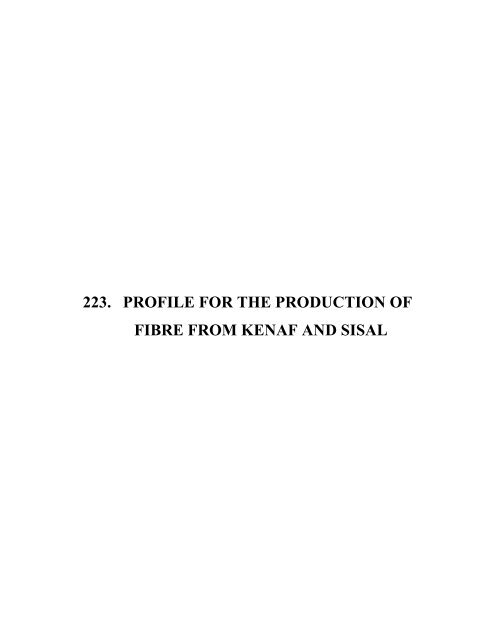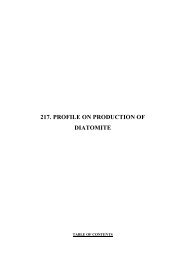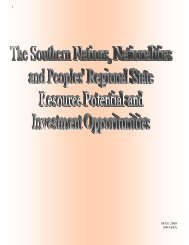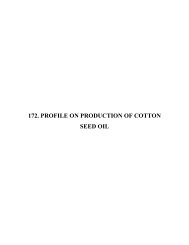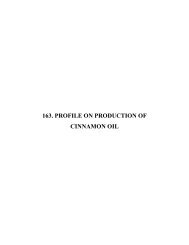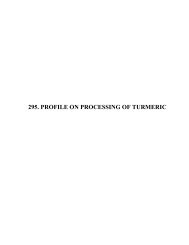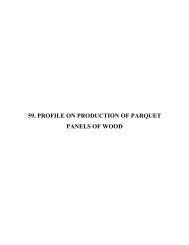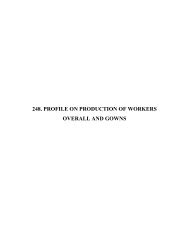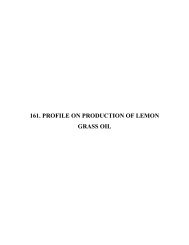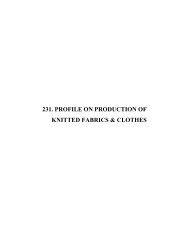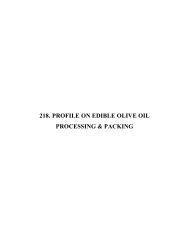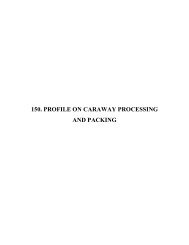Profile for the Production of Fibre From Kenaf and Sisal - SNNPR ...
Profile for the Production of Fibre From Kenaf and Sisal - SNNPR ...
Profile for the Production of Fibre From Kenaf and Sisal - SNNPR ...
Create successful ePaper yourself
Turn your PDF publications into a flip-book with our unique Google optimized e-Paper software.
223. PROFILE FOR THE PRODUCTION OFFIBRE FROM KENAF AND SISAL
223-2TABLE OF CONTENTSPAGEI. SUMMARY 223-3II. PRODUCT DESCRIPTION & APPLICATION 223-3III. MARKET STUDY AND PLANT CAPACITY 223-4A. MARKET STUDY 223-4B. PLANT CAPACITY & PRODUCTION PROGRAMME 223-7IV. RAW MATERIALS AND INPUTS 223-8A. RAW & AUXILIARY MATERIALS 223-9B. UTILITIES 223-9V. TECHNOLOGY & ENGINEERING 223-10A. TECHNOLOGY 223-11B. ENGINEERING 223-11VI. MANPOWER & TRAINING REQUIREMENT 223-11A. MANPOWER REQUIREMENT 223-12B. TRAINING REQUIREMENT 223-12VII. FINANCIAL ANALYSIS 223-13A. TOTAL INITIAL INVESTMENT COST 223-13B. PRODUCTION COST 223-14C. FINANCIAL EVALUATION 223-15D. ECONOMIC BENEFITS 223-16
223-3I. SUMMARYThis pr<strong>of</strong>ile envisages <strong>the</strong> establishment <strong>of</strong> a plant <strong>for</strong> <strong>the</strong> production <strong>of</strong> fibre from kenaf<strong>and</strong> sisal with a capacity <strong>of</strong> 10,000 tones per annum.The present dem<strong>and</strong> <strong>for</strong> <strong>the</strong> proposed product is estimated at 13,571 tones per annum.The dem<strong>and</strong> is expected to reach 19,930 tones by <strong>the</strong> year 2020.The plant will create employment opportunities <strong>for</strong> 70 persons.The total investment requirement is estimated at about Birr 8.91 million, out <strong>of</strong> whichBirr 687,500 is required <strong>for</strong> plant <strong>and</strong> machinery.The project is financially viable with an internal rate <strong>of</strong> return (IRR) <strong>of</strong> 30 % <strong>and</strong> a netpresent value (NPV) <strong>of</strong> Birr 8.75 million discounted at 8.5%.II.PRODUCT DESCRIPTION AND APPLICATION<strong>Sisal</strong> <strong>and</strong> kenaf fibre is an important raw material required <strong>for</strong> production <strong>of</strong> ropes, cords,door mats, industrial matting <strong>and</strong> various articles like shopping bags, coasters etc. Thedem<strong>and</strong> <strong>for</strong> <strong>the</strong> product is met by local production <strong>and</strong> import.Extraction <strong>of</strong> fibre from sisal leaves <strong>and</strong> kenaf tree is largely done by retting process.The production process is free from any negative impact to <strong>the</strong> environment.
223-4III.MARKET STUDY AND PLANT CAPACITYA. MARKET STUDY1. Current Dem<strong>and</strong> <strong>and</strong> SupplyThe current local industrial suppliers <strong>of</strong> sisal fiber are Meher <strong>and</strong> Ethiopia FiberFactories. Meher Fiber produces sisal fiber <strong>and</strong> ropes <strong>and</strong> clothing <strong>for</strong> variousapplications. There is no disaggregated data on production <strong>of</strong> sisal fiber. However sisalfiber <strong>and</strong> twin ropes are complementary to sisal sacks. The dem<strong>and</strong> <strong>for</strong> sisal fiber <strong>and</strong>ropes on <strong>the</strong> o<strong>the</strong>r h<strong>and</strong>, can emerge from various sources. <strong>Sisal</strong> twin ropes can bedem<strong>and</strong>ed <strong>for</strong> rural <strong>and</strong> urban households. Rural household use twin ropes to controllivestock at home or in specific place. It can also be used in housing construction to tietoge<strong>the</strong>r.The fiber is used in water supply system to give strength <strong>and</strong> tight at joining parts. It isalso used in complementary with sacks to join toge<strong>the</strong>r tips, after products are filled in toit. <strong>SNNPR</strong>S is reach in livestock <strong>and</strong> <strong>the</strong> dem<strong>and</strong> <strong>for</strong> twin rope to control livestock, <strong>for</strong>binding materials <strong>and</strong> to load goods on load animals is very high.In <strong>the</strong> absence <strong>of</strong> data on quantity <strong>of</strong> sisal fiber dem<strong>and</strong> <strong>and</strong> supply <strong>the</strong> followingassumption were used to estimate <strong>the</strong> current effective dem<strong>and</strong>. The assumption wasbased on <strong>the</strong> discussing held with experienced people <strong>and</strong> observation where everpossible.− There are 2,654,225 rural households in <strong>SNNPR</strong>S in 2006.− According to <strong>SNNPR</strong>S Regional Bureau <strong>of</strong> Finance <strong>and</strong> Economic Developmentduring <strong>the</strong> period 2000 – 2004 <strong>the</strong> average annual production <strong>of</strong> agriculturalproducts including cereals, pulses, oil seeds, vegetables, fruits, spices <strong>and</strong> root<strong>and</strong> tubers is 33,067,208 quintal which means about 33 million sacks arerequired annually to h<strong>and</strong>le agricultural products.
223-5− One kg <strong>of</strong> sisal fiber rope can be used to mend 10 pieces <strong>of</strong> sacks when filledwith products.− Each rural household in <strong>the</strong> Region will use at least 5 kg <strong>of</strong> sisal ropes perannum.Accordingly− For 30,000,000 pieces <strong>of</strong> sacks = 50,000,000 - 300,000 kgs10− For 2,654,225 house hold X 5kg sisal fiber consumption = 13,271,125 kgs− ∴Total dem<strong>and</strong> = 300 tones + 13,271 tones = 13,571 tones <strong>of</strong> sisal fiberaccordingly <strong>the</strong> current effective dem<strong>and</strong> <strong>for</strong> sisal <strong>and</strong> kenaf fiber in <strong>SNNPR</strong>Sis estimated at about 13,571 tones.2. Dem<strong>and</strong> ProjectionThe future dem<strong>and</strong> <strong>for</strong> sisal fiber is related to population growth which is 3% per annum.Accordingly <strong>the</strong> projected dem<strong>and</strong> is shown in Table 3.1
223-7that <strong>the</strong> envisaged plant will have market share with an annual production capacity <strong>of</strong>10,000 tones. <strong>Production</strong> shall be carried out in two shifts 16 hours a day, <strong>for</strong> 300 days ayear.2. <strong>Production</strong> Programme<strong>Production</strong> will start at lower capacity (75%) during <strong>the</strong> initial period <strong>of</strong> plant operationto give provisions <strong>for</strong> operational skill development <strong>and</strong> create adequate opportunity <strong>for</strong>establishing potential market out lets. Then production will rise to 85% <strong>and</strong> 100%during <strong>the</strong> second <strong>and</strong> third year, respectively. The production programme <strong>of</strong> <strong>the</strong> planttoge<strong>the</strong>r with percentage capacity utilization over <strong>the</strong> production building-up period isgiven in Table 3.2 below.Table 3.2PRODUCTION PROGRAMMEYear 1 2 3 <strong>and</strong> aboveCapacity utilization (%) 75 85 100<strong>Production</strong> (tone) 7500 8500 10,000IV.MATERIALS AND INPUTSA. RAW AND AUXILIARY MATERIALSThe basic raw materials <strong>for</strong> <strong>the</strong> production <strong>of</strong> sisal <strong>and</strong> kenaf fibers are sisal leaves <strong>and</strong>stems <strong>of</strong> kenaf plant. These raw materials are grown in <strong>SNNPR</strong>S, particularly in AwassaZuria,The fibrous materials expected to be extracted are 77.2% <strong>for</strong> sisal <strong>and</strong> about 66% <strong>for</strong>kenaf by weight. Thus, to produce 10,000 tons <strong>of</strong> sisal <strong>and</strong> kenaf fibers, <strong>the</strong> average rawmaterial requirement is estimated to be 13505 tons, assuming that 7500 tons <strong>of</strong> sisal fiber
223-8<strong>and</strong> 2500 tons <strong>of</strong> kenaf fibre will be annually produced. It is estimated that <strong>the</strong> raw sisalleave <strong>and</strong> kenaf stalk will cost Birr 1.75 per kg. Thus, <strong>the</strong> annual raw material cost at fullcapacity production is estimated to be Birr 23,633,750.B. UTILITIESElectricity <strong>and</strong> water are required in sisal <strong>and</strong> kenaf production, electricity is required <strong>for</strong>running production equipment <strong>and</strong> lighting purposes. Water is required <strong>for</strong> washing <strong>the</strong>fibres, <strong>for</strong> sanitation <strong>and</strong> human consumption. It is estimated that annual electricityconsumption will be 24,000 kWh, where as annual water consumption will be Birr 2000.Thus, <strong>the</strong> total expenditure on water <strong>and</strong> electricity will be Birr 13,376.V. TECHNOLOGY AND ENGINEERINGA. TECHNOLOGY1. <strong>Sisal</strong> <strong>Fibre</strong>The fibres are extracted from <strong>the</strong> leaves <strong>of</strong> <strong>the</strong> plant (Agave sisalana) normally grown in<strong>SNNPR</strong>S. The agaves have rosettes <strong>of</strong> fleshy leaves, usually long <strong>and</strong> narrow, whichgrow out from a central bud. As <strong>the</strong> leaves mature <strong>the</strong>y gradually spread out horizontally<strong>and</strong> are 1-2 meters long, 10-15 cms wide, with a thickness <strong>of</strong> about 6 mm at <strong>the</strong> centre.The fibres are embedded longitudinally in <strong>the</strong> leaves, <strong>and</strong> are most abundant near <strong>the</strong> leafsurfaces. The leaves contain about 90% moisture, but <strong>the</strong> fleshy pulp is very firm <strong>and</strong> <strong>the</strong>leaves are rigid. The fiber is removed when <strong>the</strong> leaves are cut because dry fibers adhereto <strong>the</strong> pulp. The fiber is removed by scraping away <strong>the</strong> pulpy material, generally by amechanical decortications process.In decortications, <strong>the</strong> leaves are fed through sets <strong>of</strong> fluted crushing rollers. The crushedleaves are held firmly at <strong>the</strong>ir centers <strong>and</strong> both ends are passed between pairs <strong>of</strong> metaldrums on which blades are mounted to scrape away <strong>the</strong> pulp, <strong>and</strong> <strong>the</strong> centers are scraped
223-10Table 5.1LIST OF PLANT MACHINERY AND EQUIPMENTNo. Description Qty Cost (‘000 Birr)LC FC TCA. <strong>Sisal</strong> <strong>Fibre</strong> <strong>Production</strong>1 Fluted crushing rollers (with motor 4 sets - 320 320& control panel)2 Metal drums (with mounted 4 paris - 80 80(blades) (Revolving)3 Washing basins (stainless steel) 2 pcs 20 - 204 Revolving metal drums (with 2 pcs - 50 50motor <strong>and</strong> control panel)5 Tables, h<strong>and</strong> tools, etc. Reqd. - 17.5B. <strong>Kenaf</strong> fibre production1 Cutting knife 10- 20 20sets2 Mechanical stripping device 5 sets - 15 153 Washing basin (stainless steel) 4 pcs 40 - 404 Tables, h<strong>and</strong> tools, etc. Reqd. - 15 15FOB price 60 517.50 577.50Freight, Insurance, customs, bank110 - 110chargesCIF l<strong>and</strong>ed cost 170 517.50 687.502. L<strong>and</strong>, Building <strong>and</strong> Civil WorksL<strong>and</strong> is required <strong>for</strong> factory building <strong>and</strong> <strong>for</strong> annex buildings that comprise <strong>of</strong> <strong>of</strong>fices,cafeteria, guard houses <strong>and</strong> buildings <strong>for</strong> utilities. Spare l<strong>and</strong> <strong>for</strong> future expansion is alsorequired. Thus, <strong>the</strong> total l<strong>and</strong> requirement is estimated to be 3000 m 2 . Of this built-uparea will be 1500 m 2 . At <strong>the</strong> rate <strong>of</strong> Birr 1.0 per m2 <strong>for</strong> a period <strong>of</strong> 80 years <strong>the</strong> total
223-11l<strong>and</strong> lease value will be Birr 240,000. For built-up area <strong>of</strong> 1500 m 2 , <strong>and</strong> at <strong>the</strong> rate <strong>of</strong> Birr2000 per m 2 , <strong>the</strong> total investment on buildings will be Birr 3 million. Thus, <strong>the</strong> total coston l<strong>and</strong>, buildings <strong>and</strong> civil works will be Birr 3.24 million.3. Proposed LocationLocation <strong>of</strong> a plant is determined on <strong>the</strong> basis <strong>of</strong> proximity to raw material, availability <strong>of</strong>infrastructure, <strong>and</strong> distance from potential market outlets. Moreover, consideration isgiven to fair distribution <strong>of</strong> projects among <strong>SNNPR</strong>S woredas. Accordingly, Hadiya,Sidama <strong>and</strong> Awassa Zurea are identified. The four woredas where kenaf <strong>and</strong> sisal plantgrow are Badawacho, Aleta Dale <strong>and</strong> Awassa Zuria. Of <strong>the</strong>se Badawacho woreda isselected. It is <strong>the</strong>re<strong>for</strong>e appropriate to establish <strong>the</strong> proposed fibre production plant inshone town.VI.MANPOWER AND TRAINING REQUIREMENTA. MANPOWER REQUIREMENTThe envisaged fibre production plant requires both administration staff <strong>and</strong> productionworkers. The details <strong>of</strong> manpower are shown in Table 6.1 below.B. TRAINING REQUIREMENTThe production <strong>of</strong> fibre from sisal leaves <strong>and</strong> kenaf plant does not require specializedtraining workers having experience in machinery operation in o<strong>the</strong>r factories <strong>and</strong> withqualification in technical studies from TVETS can h<strong>and</strong>le <strong>the</strong> production process.
223-12Table 6.1MANPOWER REQUIREMENTNo. Job Title Nos Monthly Annual SalarySalaryA. Administration1 Plant manager 1 2000 240002 Secretary 1 800 96003 Personnel <strong>of</strong>ficer 1 1000 120004 Accountant 1 1000 120005 Store keeper 1 750 90006 Sales man 1 750 90007 Cashier 1 600 72008 Driver 2 500 60009 Cleaner 2 250 300010 Messenger 2 350 420011 Guards 4 250 3000Sub total 17 - 99,000B. <strong>Production</strong>1 <strong>Production</strong> head 2 1200 288002 Mechanic / electrician 4 700 336003 Skilled operators 30 500 1800004 Unskilled labor 15 250 450005 <strong>Production</strong> clerk 2 500 12000Sub-total 53 - 299.400Workers benefit (25 % BS) - - 99,600Total 70 - 497,600
223-13VII. FINANCIAL ANALYSISThe financial analysis <strong>of</strong> <strong>the</strong> fiber from kenaf <strong>and</strong> sisal project is based on <strong>the</strong> datapresented in <strong>the</strong> previous chapters <strong>and</strong> <strong>the</strong> following assumptions:-Construction period1 yearSource <strong>of</strong> finance30 % equity70 % loanTax holidays3 yearsBank interest 8%Discount cash flow 8.5%Accounts receivable30 daysRaw material local30daysWork in progress5 daysFinished products30 daysCash in h<strong>and</strong>5 daysAccounts payable30 daysA. TOTAL INITIAL INVESTMENT COSTThe total investment cost <strong>of</strong> <strong>the</strong> project including working capital is estimated at Birr8.91 million, <strong>of</strong> which 29 per cent will be required in <strong>for</strong>eign currency.The major breakdown <strong>of</strong> <strong>the</strong> total initial investment cost is shown in Table 7.1.
223-14Table 7.1INITIAL INVESTMENT COSTSr.No.Cost ItemsTotal Cost(‘000 Birr)1 L<strong>and</strong> lease value 2402 Building <strong>and</strong> Civil Work 3,000.003 Plant Machinery <strong>and</strong> Equipment 687.504 Office Furniture <strong>and</strong> Equipment 755 Vehicle 2006 Pre-production Expenditure* 373.417 Working Capital 4343.59Total Investment cost 8,919.5Foreign Share 29* N.B Pre-production expenditure includes interest during construction (Birr273,410 ) <strong>and</strong> Birr 100 thous<strong>and</strong> costs <strong>of</strong> registration, licensing <strong>and</strong> <strong>for</strong>mation <strong>of</strong> <strong>the</strong>company including legal fees, commissioning expenses, etc.B. PRODUCTION COSTThe annual production cost at full operation capacity is estimated at Birr 24.89 million(see Table 7.2). The material <strong>and</strong> utility cost accounts <strong>for</strong> 95.12 per cent, while repair<strong>and</strong> maintenance take 0.30 per cent <strong>of</strong> <strong>the</strong> production cost.
223-15Table 7.2ANNUAL PRODUCTION COST AT FULL CAPACITY ('000 BIRR)Items Cost %Raw Material <strong>and</strong> Inputs23,633.75 95.07Utilities13.38 0.05Maintenance <strong>and</strong> repair75 0.30Labour direct298.56 1.20Factory overheads99.52 0.40Administration Costs199.04 0.80Total Operating Costs24,319.25 97.82Depreciation286.25 1.15Cost <strong>of</strong> Finance254.48 1.02Total <strong>Production</strong> Cost 24,859.98 100C. FINANCIAL EVALUATION1. Pr<strong>of</strong>itabilityAccording to <strong>the</strong> projected income statement, <strong>the</strong> project will start generating pr<strong>of</strong>it in <strong>the</strong>first year <strong>of</strong> operation. Important ratios such as pr<strong>of</strong>it to total sales, net pr<strong>of</strong>it to equity(Return on equity) <strong>and</strong> net pr<strong>of</strong>it plus interest on total investment (return on totalinvestment) show an increasing trend during <strong>the</strong> life-time <strong>of</strong> <strong>the</strong> project.The income statement <strong>and</strong> <strong>the</strong> o<strong>the</strong>r indicators <strong>of</strong> pr<strong>of</strong>itability show that <strong>the</strong> project isviable.
223-162. Break-even AnalysisThe break-even point <strong>of</strong> <strong>the</strong> project including cost <strong>of</strong> finance when it starts to operate atfull capacity (year 3) is estimated by using income statement projection.BE = Fixed Cost = 19 %Sales – Variable Cost3. Payback PeriodThe investment cost <strong>and</strong> income statement projection are used to project <strong>the</strong> pay-backperiod. The project’s initial investment will be fully recovered within 4 years.4. Internal Rate <strong>of</strong> Return <strong>and</strong> Net Present ValueBased on <strong>the</strong> cash flow statement, <strong>the</strong> calculated IRR <strong>of</strong> <strong>the</strong> project is 30 % <strong>and</strong> <strong>the</strong> netpresent value at 8.5% discount rate is Birr 8.75 million.D. ECONOMIC BENEFITSThe project can create employment <strong>for</strong> 70 persons. In addition to supply <strong>of</strong> <strong>the</strong> domesticneeds, <strong>the</strong> project will generate Birr 5.93 million in terms <strong>of</strong> tax revenue.


